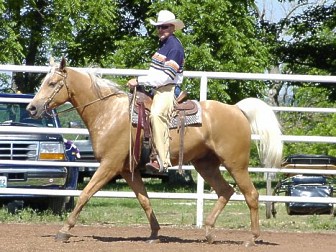
OVERVIEW
The Missouri Fox Trotter was developed at the time of the American expansion westward. The need for a comfortable riding horse that could provide a smooth gait over various types of terrain was the main impetus of the breeder. First established in the Ozark Mountains of Missouri and Arkansas, the Missouri Fox Trotter was quickly known for its unique natural gait, a walking motion in the front with a quick sliding trot in the rear. The horse could keep this gait for long distances without tiring at a comfortable speed of 5 to 8 mph.
PHYSICAL DESCRIPTION
A horse of basic Spanish ancestry, the Missouri Fox Trotter is a hardy horse with good action. Generally chestnut, the horse can be found in any color. It stands between 14 and 16 hands high. The body is refined and graceful appearing. The head is clean, relatively neat and intelligent with large, attentive eyes. The horse is known for its comfortable ride with little movement in the back.
ORIGIN
For years before the Missouri Fox Trotter was actually standardized as a type (the stud book opening in 1948) settlers interbred with Morgans, Thoroughbreds, Arabians, and Spanish horses. After some time, in the Ozark mountains of Missouri and Arkansas, a horse was developed that evolved an ideal gait. Over the years, Saddlebred and Tennessee Walkers were introduced to the line refining the Fox Trotter and giving it a more pleasing disposition. Many great lines of Fox Trotters had evolved long before the stud book was first opened; two such lines include the pre-Civil War Bremmers Ozark line and the Kissees family who began the Diamond and Fox strains mainly using horses from Illinois and Kentucky. Other influences have come from Danish strains of Saddlebreds.
INTERESTING FACTS
Used mainly for western tack, the Missouri Fox Trotter began to decline in popularity and numbers as industrialization progressed. In an effort to save the vanishing breed, a group of horsemen opened a stud book in 1948. The horse soon regained popularity as a fine trail-riding horse mainly because of its sure-footedness and pleasant riding gait. It is also shown in three gaits: the flat foot walk, the fox trot, and the canter. By 2004 there were over 80,000 registered in the US and foreign countries. This is one of the fastest growing breeds of horses and is gaining popularity. The National show, which spans 7 days has both performance and versatility classes. 2004 had the first ever working cow horse competition using the Missouri Fox Trotter.
INFLUENCES
1. Saddlebred
2. Spanish
3. Morgan
For more information:
Missouri Fox Trotting Horse Breed Association
Photo from Mandy Baledge